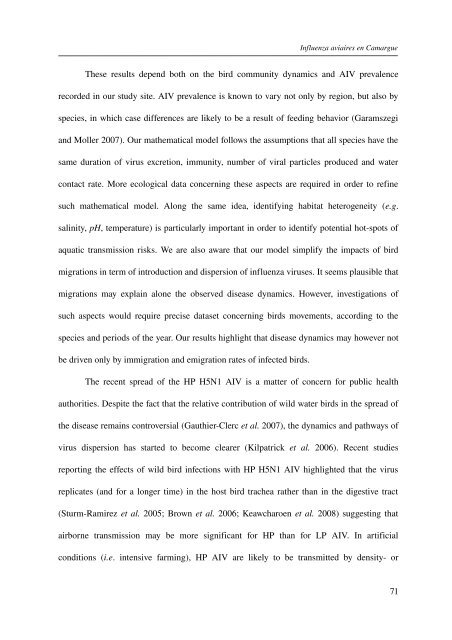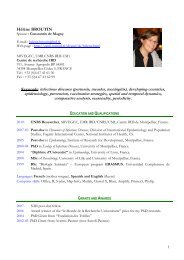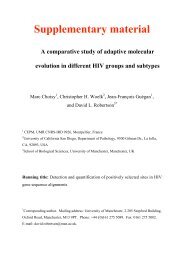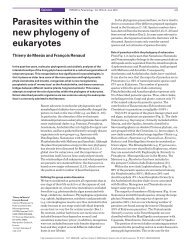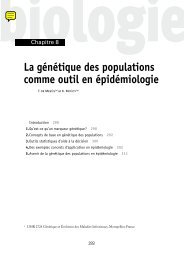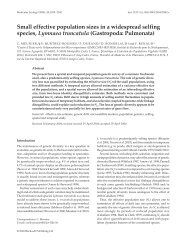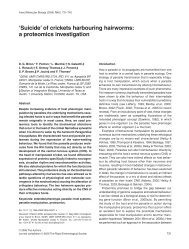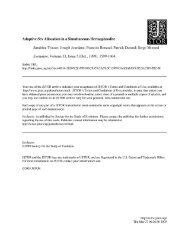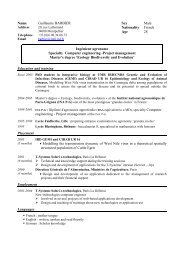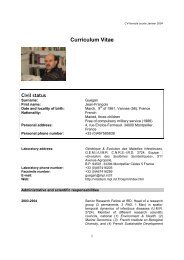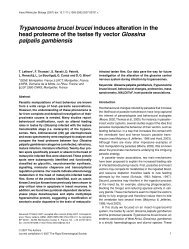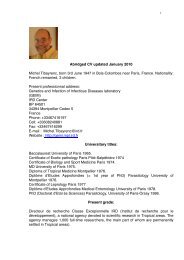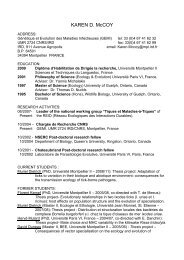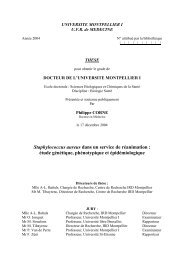écologie des virus influenza aviaires en Camargue - IRD
écologie des virus influenza aviaires en Camargue - IRD
écologie des virus influenza aviaires en Camargue - IRD
Create successful ePaper yourself
Turn your PDF publications into a flip-book with our unique Google optimized e-Paper software.
Influ<strong>en</strong>za <strong>aviaires</strong> <strong>en</strong> <strong>Camargue</strong>These results dep<strong>en</strong>d both on the bird community dynamics and AIV preval<strong>en</strong>cerecorded in our study site. AIV preval<strong>en</strong>ce is known to vary not only by region, but also byspecies, in which case differ<strong>en</strong>ces are likely to be a result of feeding behavior (Garamszegiand Moller 2007). Our mathematical model follows the assumptions that all species have thesame duration of <strong>virus</strong> excretion, immunity, number of viral particles produced and watercontact rate. More ecological data concerning these aspects are required in order to refinesuch mathematical model. Along the same idea, id<strong>en</strong>tifying habitat heterog<strong>en</strong>eity (e.g.salinity, pH, temperature) is particularly important in order to id<strong>en</strong>tify pot<strong>en</strong>tial hotspots ofaquatic transmission risks. We are also aware that our model simplify the impacts of birdmigrations in term of introduction and dispersion of <strong>influ<strong>en</strong>za</strong> <strong>virus</strong>es. It seems plausible thatmigrations may explain alone the observed disease dynamics. However, investigations ofsuch aspects would require precise dataset concerning birds movem<strong>en</strong>ts, according to thespecies and periods of the year. Our results highlight that disease dynamics may however notbe driv<strong>en</strong> only by immigration and emigration rates of infected birds.The rec<strong>en</strong>t spread of the HP H5N1 AIV is a matter of concern for public healthauthorities. Despite the fact that the relative contribution of wild water birds in the spread ofthe disease remains controversial (GauthierClerc et al. 2007), the dynamics and pathways of<strong>virus</strong> dispersion has started to become clearer (Kilpatrick et al. 2006). Rec<strong>en</strong>t studiesreporting the effects of wild bird infections with HP H5N1 AIV highlighted that the <strong>virus</strong>replicates (and for a longer time) in the host bird trachea rather than in the digestive tract(SturmRamirez et al. 2005; Brown et al. 2006; Keawcharo<strong>en</strong> et al. 2008) suggesting thatairborne transmission may be more significant for HP than for LP AIV. In artificialconditions (i.e. int<strong>en</strong>sive farming), HP AIV are likely to be transmitted by d<strong>en</strong>sity or71


